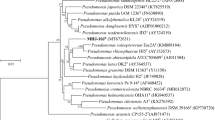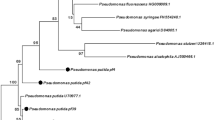Abstract
The genetic diversity among indigenous phenazine-1-carboxylic acid (PCA)-producing and pyoluteorin (Plt)-producing isolates of pseudomonads screened from green pepper rhizosphere was exploited in this study. A total of 48 bacterium isolates producing one or both of these antibiotics were screened from green pepper rhizosphere in diverse regions in China. Among these isolates, 45 could produce PCA, 3 could produce both PCA and Plt, and none could produce Plt only. Based on the restriction patterns of partial 16S and 16S-23S internal transcribed spacer (ITS) PCR fragments generated by enzyme HaeIII or HinfI, these isolates fell into 19 or 17 distinct groups respectively, indicating that there was a significant diversity among them. Polygenetic analysis of the partial 16S rDNA and 16S-23S ITS sequence from the representative in each group in the context of similar sequence from previously described bacterial species indicated that most isolates were closely related to the species of Pseudomonas fluorescens, P. putida, and Stenotrophomonas maltophilia. Some of these representatives of these isolates, then, are likely to be novel strains or species in these two genera.


Similar content being viewed by others
References
Ausubel FM, Brent R, Kingston RE, Moore DD, Seidman JG, Smith JA, Struhl K (eds) (1995) Short protocols in molecular biology. Wiley, New York
Barry T, Colleran G, Glennon M, Dunican L, Gannon F (1991) The 16S/23S ribosomal spacer region as a target for DNA probes to identify eubacteria. PCR Methods Appl 1:51–56
Bender CL, Rangaswamy V, Loper JE (1999) Polyketide production by plant-associated pseudomonads. Annu Rev Phytopathol 37:175–196
Brodhagen M, Henkels MD, Loper JE (2004) Positive autoregulation and signaling properties of pyoluteorin, an antibiotic produced by the biological control organism Pseudomonas fluorescens Pf-5. Appl Environ Microbiol 70:1758–1766
Codon C, Squires C, Squires CL (1995) Control of rRNA transcription in Escherichia coli. Microbiol Rev 59:623–645
Dawson SL, Fry JC, Dancer BN (2002) A comparative evaluation of five typing techniques for determining the diversity of fluorescent pseudomonads. J Microbiol Methods 50:9–22
Dobrint U, Hacker J (2001) Whole genome plasticity in pathogenic bacteria. Curr Opin Microbiol 4:550–557
Engebretson JJ, Moyer CL (2003) Fidelity of select restriction endonucleases in determining microbial diversity by terminal-restriction fragment length polymorphism. Appl Environ Microbiol 69:4823–4829
Fenton AM, Stephens PM, Crowley J, O’Callaghan M, O’Gara F (1992) Exploitation of gene (s) involved in 2,4-diacetylphloroglucinol biosynthesis to confer a new biocontrol capability to a Pseudomonas strain. Appl Environ Microbiol 58:3873–3878
Garbeva P, Van Veen JA, Van Elsas JD (2004) Assessment of the diversity, and antagonism towards Rhizoctonia solani AG3, of Pseudomonas species in soil from different agricultural regimes. FEMS Microbiol Ecol 47:51–64
Garbeva P, Van Veen JA, Van Elsas JD (2004) Microbial diversity in soil: selection microbial populations by plant and soil type and implications for disease suppressiveness. Annu Rev Phytopathol 42:243–270
Garcýa-Martýnez J, Acinas SG, Anton AI, Rodrýguez-Valera F (1999) Use of the 16S–23S ribosomal genes spacer region in studies of prokaryotic diversity. J Microbiol Methods 36:55–64
Ge YH, Huang XQ, Wang SL, Zhang XH, Xu YQ (2004) Pyoluteorin is positively regulated and phenazine-1-carboxylic acid negatively regulated by gacA in Pseudomonas sp. M-18. FEMS Microbiol Lett 237:39–45
Girvan MS, Bullimore J, Pretty JN, Osborn AM, Ball AS (2003) Soil type is the primary determinant of the composition of the total and active bacterial communities in arable soils. Appl Environ Microbiol 69:1800–1809
Gurtler V, Stanisich VA (1996) New approaches to typing and identification of bacteria using the 16S–23S rDNA spacer. Microbiology 142:3–16
Hammer PE, Hill DS, Lam ST, Van Pe.e K-H, Ligon JM (1997) Four genes from Pseudomonas fluorescens that encode the biosynthesis of pyrrolnitrin. Appl Environ Microbiol 63:2147–2154
Handelsman J, Stabb EV (1996) Biocontrol of soil-borne plant pathogens. Plant Cell 8:1855–1869
Haas D, Défago G (2005) Biological control of soil-borne pathogens by fluorescent pseudomonads. Nature Reviews Microbiology 3:309–319
Huang XQ, Zhu DH, Ge YH, Zhang XH, Xu YQ (2004) Identification and characterization of pltZ, a gene involved in the repression of pyoluteorin biosynthesis in Pseudomonas sp. M18 FEMS Microbiol Lett 232:197–202
Hu HB, Xu YQ, Cheng F, Zhang XH, Hur B (2005) Isolation and characterization of a new Pseudomonas strain produced both phenazine 1-carboxylic acid and pyoluteorin. J Microbiol Biotech 15:86–90
James DW, Gutterson NI (1986) Multiple antibiotics produced by Pseudomonas fluorescens HV37a and their differential regulation by glucose. Appl Environ Microbiol 52:1183–1198
Jeng RS, Svircev AM, Myers AL, Beliaeva L, Hunter DM, Hubbes M (2001) The use of 16S and 16S–23S rDNA to easily detect and differentiate common Gram-negative orchard epiphytes. J Microbiol Methods 44:69–77
Keel C, Weller DM, Natsch A, Défago G, Cook RJ, Thomashow LS (1996) Conservation of the 2,4-diacetylphloroglucinol biosynthesis locus among fluorescent Pseudomonas strains from diverse geographic locations. Appl Environ Microbiol 62:552–563
King EO, Ward MK, Raney DE (1954) Two simple media for demonstration of pyocyanin and fluorescein. J Lab Clin Med 44:301–307
Kluyver AJ (1956) Pseudomonas aureofaciens nov.spec. and its pigments. J Bacteriol 72:406–411
Landa BB, Mavrodi OV, Raaijmakers JM, Mcspadden Gardener BB, Thomashow LS, Weller DM (2002) Differntial ability of genotypes of 2,4-Diacetylphloroglucinol-producing Pseudomonas fluorescens strains to colonize the roots of pea plants. Appl Environ Microbiol 68:3226–3237
Latour X, Corberand T, Laguerre G, Allard F, Lemanceau P (1996) The composition of fluorescent Pseudomonas populations associated with roots is influenced by plant and soil type. Appl Environ Microbiol 62:2449–2456
Lemanceau P, Corberand T, Gardan L, Latour X, Laguerre G, Boeufgras J, Alabouvette C (1995) Effect of two plant species, flax (Linumusitatissimum L.) and tomato (Lycopersicon esculentum Mill.), on the diversity of soil-borne populations of fluorescent pseudomonads. Appl Environ Microbiol 61:1004–1012
Ligon JM, Hill DS, Hammer PE, Torkewitz NR, Hofmann D, Kempf H-S, Van Pee K-H (2000) Natural products with antifungal activity from Pseudomonas biocontrol bacteria. Pest Manag Sci 56:688–695
Locatelli L, Tarnawski S (2002) Specific PCR amplification for the genus Pseudomonas targeting the 3’ half of 16s rDNA and the whole 16S-23S rDNA spacer. Syst Appl Microbiol 25:220–227
Marschner P, Crowley D, Yang CH (2004) Development of specific rhizosphere bacterial communities in relation to plant species, nutrition and soil type. Plant Soil 261:199–208
Mcspadden Gardener BB, Schroeder KL, Kalloger SE, Raaijmakers JM, Thomashow LS, Weller DM (2000) Genotypic and phenotypic diversity of PhlD-containing Pseudomonas strains isolated from the rhizosphere of wheat. Appl Environ Microbiol 66:1939–1946
Moyer CL, Tiedje JM., Dobbs FC, Karl1 DM (1996) A computer-simulated restriction fragment length polymorphism analysis of bacterial small-subunit rRNA genes: efficacy of selected tetrameric restriction enzymes for studies of microbial diversity in nature. Appl Environ Microbiol 62:2501–2507
Ohmori T, Hagiwara S-I, Ueda A, Minoda Y, Yamada K (1978) Production of pyoluteorin and its derivatives from n-paraffin by Pseudomonas aeruginosa S10B2. Agric Biol Chem 42:2031–2036
O’Sullivan DJ, O’Gara F (1992) Traits of fluorescent Pseudomonas spp. involved in suppression of plant root pathogens. Microbio Rev 56:662–672
Raaijmakers JM., Weller DM, Thomashow LS (1997) Frequency of antibiotic-producing Pseudomonas spp. in natural environments. Appl Environ Microbiol 63:881–887
Takeda R (1958) Pseudomonas pigments. I. Pyoluteorin, a new chlorine-containing pigment produced by Pseudomonas aeruginosa. Hako Kogaku Zasshi 36:281–290
Thomas FC, Woeng CA, Bloemberg GV, Lugtenberg BJJ (2003) Phenazines and their role in biocontrol by Pseudomonas bacteria. New Phytol 157:503–523
Thomashow LS, Weller DM (1996) Current concepts in the use of introduced bacteria for biological disease control: mechanisms and antifungal metabolites. In: Stacey G, Keen NT (eds) Plant–Microbe interactions. Chapman and Hall Ltd, London, pp 187–236
Trček J, Teube M (2002) Genetic and restriction analysis of the 16S-23S rDNA internal transcribed spacer regions of the acetic acid bacteria. FEMS Microbiol Lett 208:69–75
Turner JM, Messenger AJ (1986) Occurrence, biochemistry and physiology of phenazine pigment production. Adv Microb Physiol 27:211–275
Voisard C, Keel C, Haas D, Défago G (1989) Cyanide production by Pseudomonas fluorescens helps suppress black root rot of tobacco under gnotobiotic conditions. EMBO J 8:351–358
Wang L, Jayarao BM (2001) Phenotypic and genotypic characterization of Pseudomonas fluorescens isolated from bulk tank milk. J Dairy Sci 84:1421–1429
Weller DM, Raaijmakers JM, Mcspadden Gardener BB, Thomashow LS (2002) Microbial populations responsible for specific soil suppressiveness to plant pathogens. Annu Rev Phytopathol 40:309–348
Acknowledgments
Dr. Linda S. Thomashow is thanked for her valuable suggestions of this manuscript. This work was financially supported both by Grant No. 2004BA308A02–14 from the Tenth Five-Year Programs of Chinese National Science and Technology Development and Grant No. 30370041 from the National Science Foundation of China.
Author information
Authors and Affiliations
Corresponding author
Additional information
The GenBank accession numbers for DNA sequences of the partial 16S rDNA with ITS region in each isolate determined in this study were: GP30 DQ003219; GP127 DQ003220; GP83 DQ003221; GP42, DQ003222; GP59 DQ003223; GP50 DQ003224; GP36 DQ003225; GP110 DQ003226; GP26 DQ003227; GP37 DQ003228; GP60 DQ003229; GP31 DQ003230; GP57 DQ003231; GP75 DQ003232; GP115 DQ003233; GP65 DQ003234; GP32 DQ003235; GP76 DQ003236; GP78 DQ003237.
Rights and permissions
About this article
Cite this article
Liu, H., Dong, D., Peng, H. et al. Genetic diversity of phenazine- and pyoluteorin-producing pseudomonads isolated from green pepper rhizosphere. Arch Microbiol 185, 91–98 (2006). https://doi.org/10.1007/s00203-005-0072-6
Received:
Revised:
Accepted:
Published:
Issue Date:
DOI: https://doi.org/10.1007/s00203-005-0072-6




